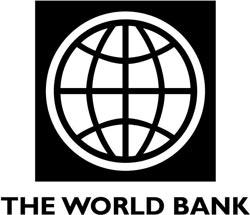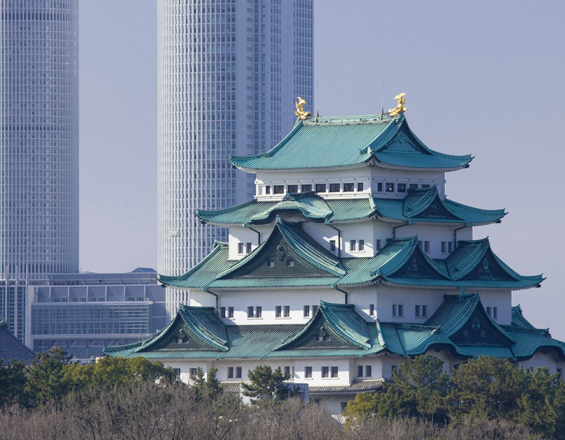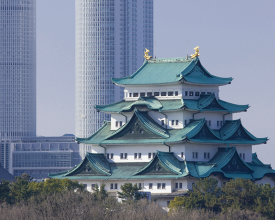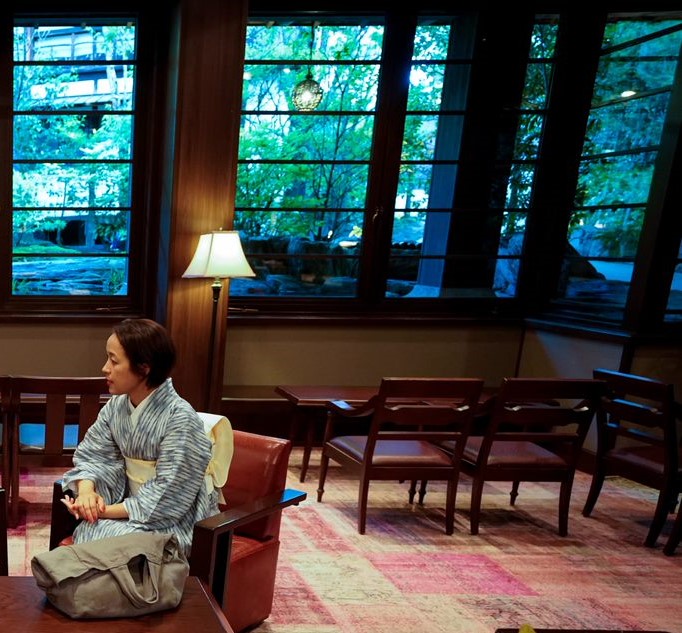
Restaurar la ciudad devastada por la guerra

Con 2,30 millones de habitantes, Nagoya es la tercera ciudad más grande de Japón, sin contar Tokio. La ciudad es única en el sentido de que ha desarrollado una variedad de entornos urbanos para la competitividad global, como redes de transporte, distritos comerciales de gran altura y centros de industrias de valor añadido. Estos elementos urbanos están bien organizados, con amplias zonas verdes y vías arteriales que permiten una circulación fluida del tráfico en el distrito central de negocios. Sin embargo, durante la Segunda Guerra Mundial, la ciudad quedó devastada. Inmediatamente después del fin de la guerra, la ciudad de Nagoya comenzó sus programas de restauración por la vía rápida que posteriormente establecieron la ciudad tal y como es hoy en día bajo la fuerte iniciativa del gobierno de la ciudad.
Contexto
Défis à relever
Antes de la II Guerra Mundial, Nagoya creció como ciudad industrial líder donde muchos gigantes de la industria pesada ubicaron sus principales fábricas. Como la ciudad era también un importante centro de producción de aviones de combate y otra maquinaria relacionada con la guerra, se convirtió en uno de los principales objetivos de la política de "tierra quemada" del ejército estadounidense. Los sucesivos ataques aéreos devastaron una cuarta parte de la ciudad y su población se redujo a la mitad del máximo alcanzado en la década de 1930.
Ubicación
Procesar
Resumen del proceso
Para guiar adecuadamente la rápida urbanización durante un periodo de restauración tras una catástrofe o un conflicto, los gobiernos locales deben tomar inmediatamente iniciativas de desarrollo y aplicar los planes de restauración a tiempo. Sus respuestas rápidas y enérgicas permiten controlar la urbanización no sistemática y acelerar el sucesivo crecimiento urbano y económico a gran escala a largo plazo. Entre las diversas políticas de restauración que adoptó la ciudad de Nagoya, los programas proactivos de reajuste de tierras contribuyeron a redefinir los límites de las parcelas, aumentaron la proporción de bienes públicos de la ciudad y apoyaron la rápida reconstrucción de la ciudad.
Bloques de construcción
Ejecución inmediata del Plan de Restauración de Posguerra mediante una fuerte iniciativa del gobierno municipal
Sorprendentemente, los esfuerzos de restauración de la ciudad en la posguerra comenzaron sólo un mes después del fin de la guerra, en agosto de 1945. Para empezar, la ciudad reguló las nuevas urbanizaciones, ya que muchas viviendas provisionales se construyeron arbitrariamente en zonas incendiadas. En junio de 1946, la ciudad elaboró un plan de reconstrucción de posguerra que abarcaba 4.400 ha de zona urbanizada, y lo puso en marcha de inmediato. La pronta aplicación del plan dio lugar a resultados diferentes a los de otras ciudades. A pesar de que en 1949 el gobierno nacional recortó los planes de reconstrucción de muchas otras ciudades, el plan de Nagoya no se vio influido significativamente porque la ciudad ya había ejecutado el 90% del proceso de replanificación de los terrenos provisionales. En particular, se planearon 16 "carreteras de cien metros" (carreteras con una anchura de 100 metros) en todo el país, pero sólo tres carreteras -dos en Nagoya y una en Hiroshima- se construyeron realmente. Nagoya logró una notable recuperación y crecimiento; la superficie total de la ciudad se duplicó y la población superó el millón de habitantes, tan sólo cinco años después de la guerra.
Factores facilitadores
- Normas localizadas para aplicar el plan de reajuste de tierras, ampliamente utilizado para las actividades de regeneración de posguerra
- Regulación del desarrollo de nuevas viviendas en las zonas incendiadas inmediatamente después de la guerra
- Aplicar con prontitud el plan de restauración dirigido por el gobierno municipal.
Lección aprendida
Para mantener el desarrollo de la ciudad en el buen camino durante un periodo de restauración tras una catástrofe o un conflicto, los gobiernos locales deben tomar inmediatamente iniciativas de desarrollo, controlar la urbanización no sistemática y acelerar el crecimiento urbano y económico sucesivo a gran escala. Además, las actitudes positivas de una ciudad para lograr una restauración urbana acelerada podrían motivar fuertemente a los ciudadanos a realizar esfuerzos cooperativos para revitalizar su ciudad.
Orientar la urbanización mediante reajustes proactivos del suelo
La ciudad estableció un programa de reajuste de tierras a gran escala en el marco del plan de reconstrucción. La ciudad designó casi toda el área de reajuste a finales de 1949. El reajuste contribuyó a redefinir los límites de las parcelas de tierra que se volvieron borrosas en las zonas devastadas por la guerra y apoyó la rápida reconstrucción de la ciudad. Como resultado del reajuste, la proporción de bienes públicos de la ciudad se incrementó significativamente: las áreas de carreteras en 2,12 veces (2,36 veces en el centro urbano); los parques públicos en 3,07 veces; las áreas totales para cementerios en 1,30 veces; y las plazas de las estaciones en 5,25 veces. El proyecto de reajuste continuó hasta 1998 y, durante la rápida industrialización en torno a 1960, el reajuste del suelo se convirtió en una forma eficaz de evitar la expansión incontrolada hacia los suburbios. La ciudad amplió sus límites urbanos fusionando los pueblos y aldeas circundantes y llevó a cabo reasentamientos para acomodar a la creciente población.
Factores facilitadores
- Normas localizadas para aplicar el plan de reajuste del suelo, ampliamente utilizado para las actividades de regeneración de posguerra.
- Límites de crecimiento que separaban la ciudad en Áreas de Promoción de la Urbanización (APU) y Áreas de Control de la Urbanización (ACU)
Lección aprendida
En el plan de reconstrucción se trazó una visión ideal y de futuro para la ciudad, lo que ayuda a reajustar el uso del suelo y a crear una cierta cantidad de espacios públicos para el futuro desarrollo económico y la sostenibilidad medioambiental. Sin embargo, al mismo tiempo, podría ser un riesgo para las ciudades ampliar arbitrariamente el límite urbano durante el periodo de restauración, ya que los reajustes del suelo se vuelven largos y costosos. Así pues, para guiar adecuadamente la rápida urbanización, es esencial regular de forma proactiva los nuevos desarrollos inmobiliarios, especialmente en las zonas suburbanas en expansión, y acelerar la creación de consenso entre una serie de partes interesadas con fuertes incentivos económicos y/o interacciones sociales.
Impactos
Impacto económico: Los desafiantes programas urbanos (es decir, los programas de reajuste de tierras a gran escala, el desarrollo de carreteras extremadamente anchas y la controvertida reubicación de cementerios) contribuyeron a establecer los cimientos de la ciudad que posteriormente impulsaron un alto crecimiento económico desde los años cincuenta hasta los setenta. Por ejemplo, las carreteras de cien metros, junto con otras arterias construidas en la posguerra, constituyen un sistema de transporte para toda la ciudad que ha sido capaz de acomodar la rápida motorización y apoyar el desarrollo industrial de las últimas décadas.
Impacto social: La rápida puesta en marcha de la reconstrucción contribuyó a la rápida recuperación de la posguerra, lo que también contribuyó a mejorar la vida de la población. El aumento de los parques urbanos y las instalaciones viarias desarrolladas en el marco de los planes de reconstrucción proporcionan espacios de evacuación en caso de catástrofe y evitan la propagación de incendios. Estos espacios públicos también mejoran la seguridad de los ciudadanos y ayudan a crear entornos habitables.
Impacto medioambiental: Al reajustar una serie de parcelas, la ciudad generó una variedad de espacios verdes, incluidos espacios recreativos en el centro de las carreteras de cien metros, un gran parque como ubicación del cementerio unificado y otros nuevos parques urbanos. Estas zonas verdes contribuyeron a aumentar la amenidad y a reducir el efecto isla de calor, y también se espera que absorban las emisiones de gases de efecto invernadero en la zona urbanizada.
Beneficiarios
- Residentes de la ciudad de Nagoya
- Entidades privadas de la ciudad de Nagoya
Objetivos de Desarrollo Sostenible
Historia
Entre toda una serie de proyectos llevados a cabo durante la posguerra, tres contribuyeron de forma destacada a dicha recuperación: el reajuste de terrenos a gran escala, la reubicación de muchos cementerios y el desarrollo de carreteras de cien metros. Aparte de los programas de reajuste de tierras que se exponen en el primer bloque, a continuación se detallan estos dos empeños.
Reubicación de todos los cementerios
En Japón, los cementerios suelen formar parte de los templos budistas. Los cementerios se consideraban grandes obstáculos para el desarrollo urbano, ya que estaban situados en espacios urbanos limitados y afectaban por tanto al paisaje de la ciudad. Para impulsar el plan de reconstrucción, Nagoya decidió eliminar todos los cementerios que estaban dispersos por la zona urbanizada y consolidarlos en un nuevo parque al este de la ciudad. Aunque mucha gente se mostró muy reacia a perturbar los cementerios en aquella época, los templos se enfrentaban a graves dificultades para reconstruir sus devastadas instalaciones y había escasez de nuevos espacios para tumbas de personas fallecidas durante la guerra. La ciudad estableció un comité para la remoción de los cementerios con los templos, e hizo grandes esfuerzos para crear consenso entre los templos y las familias relacionadas. Finalmente, 279 templos y más de 180.000 tumbas fueron trasladados a un parque en una zona montañosa del este de Nagoya.
Caminos de cien metros
Las "carreteras de cien metros" (carreteras con una anchura de 100 metros) se consideraron un símbolo de la recuperación de posguerra no sólo en Nagoya sino en todo Japón. La idea de carreteras extremadamente anchas se propuso en el plan nacional de restauración de posguerra, con el objetivo de proporcionar espacios de evacuación en caso de desastre, evitar la propagación de incendios y preparar la motorización masiva. En los planes de restauración se proyectaron un total de 16 carreteras de cien metros en todo el país, pero sólo tres -dos en Nagoya y una en Hiroshima- se construyeron realmente, debido en gran parte a la política de contracción fiscal del gobierno nacional. Como se ha descrito, la aplicación inmediata de los planes de construcción hizo posible el éxito. En Nagoya se construyeron dos carreteras, una de este a oeste y otra de norte a sur, que cruzaban la ciudad. En medio de las carreteras hay grandes espacios verdes que albergan una serie de instalaciones económicas, sociales y culturales, como parques, vías rápidas elevadas, salidas de estaciones, aparcamientos y una torre de televisión.

